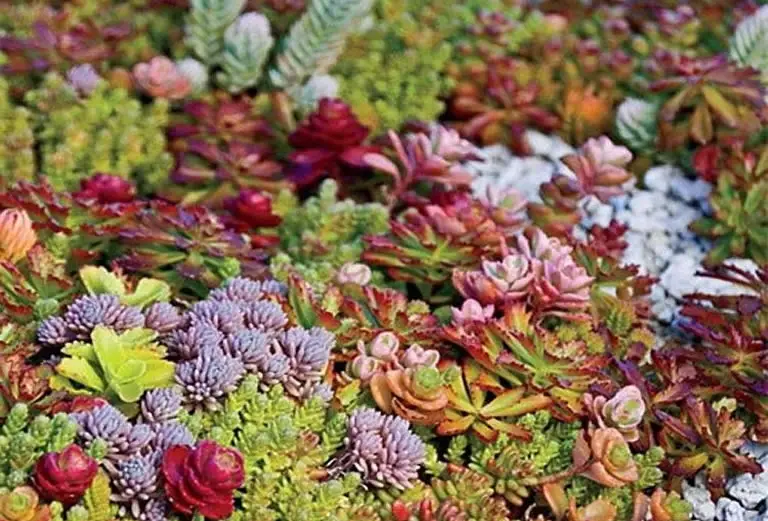Sedum plants are one of the most versatile and beginner-friendly succulents you can grow. Whether you want a trailing showpiece, a rock garden accent, or a low-maintenance container companion, sedum has a form and color for every space. With thick, fleshy leaves and excellent drought tolerance, these resilient plants require very little attention—making them perfect for both indoor and outdoor settings.
Let’s explore how to keep your sedum healthy, thriving, and looking its best all year round.
Table of Contents
The Sedum Plant: also know as Stonecrop
Sedum is a large genus of flowering succulents in the Crassulaceae family, boasting over 400 known species.
Most sedums are native to temperate regions across the Northern Hemisphere, especially Europe, Asia, and North America.
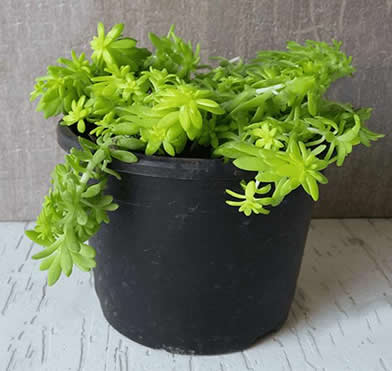
Depending on the variety, they can grow upright, form dense mats, or trail gracefully over containers.
Many people know sedum by its common name, “Stonecrop,” which refers to the plant’s ability to grow in rocky, dry, and shallow soil with ease.
The name “Sedum” comes from the Latin word sedere, meaning “to sit,” referring to its habit of hugging the ground or clinging to rocks.
Sedum plants typically have star-shaped flowers that bloom in summer or fall and attract bees and butterflies.
These hardy succulents are prized for their thick, water-storing leaves and their tolerance for heat, drought, and even poor soil.
Light Needs: Bright Light Is Best
Sedums love sunlight. Indoors, they thrive when placed near a bright, sunny window that receives at least 4 to 6 hours of direct light daily.
A south- or west-facing window is ideal for most varieties.
If your plant starts to stretch or lose color, it’s likely not getting enough light.
Outdoors, sedum does best in full sun, although some varieties can tolerate partial shade, especially in very hot climates.
Watering: Let the Soil Dry Completely
As a succulent, sedum prefers to be on the dry side.
Water thoroughly, then allow the soil to dry out completely before watering again.
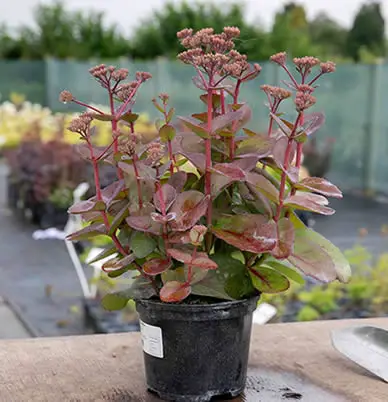
In most indoor conditions, this means watering every 10 to 14 days—but always adjust based on light, temperature, and humidity.
During the winter months, reduce watering even further as the plant enters a resting phase.
Overwatering is one of the only ways to harm sedum, so when in doubt, wait another day.
Soil and Potting: Drainage Is Key
Sedum must be planted in a well-draining soil mix to prevent rot. A commercial cactus or succulent soil blend works perfectly.
You can also make your own by mixing standard potting soil with sand, perlite, or pumice to improve aeration.
Use pots with drainage holes to avoid standing water at the roots.
Sedums are generally not fussy about nutrients, so there’s no need for rich soil.
Fertilizer: Light Feeding in Spring and Summer
Sedums don’t need much fertilizer, but a light feeding in the growing season can encourage healthier growth and more blooms.
Use a balanced liquid succulent fertilizer (such as 10-10-10 this one, or 8-8-8 like this one) diluted to half strength once a month during spring and summer.
Skip feeding during the fall and winter when the plant is resting.
Pruning and Maintenance: Tidy as Needed
Sedums require little pruning. You can trim back leggy stems or remove dried flower heads to keep your plant looking neat.

If your plant gets too large or begins to stretch, feel free to pinch or prune it back—it will quickly regrow from the base or leaf nodes.
Many sedums can be easily propagated from cuttings, making maintenance a great opportunity to grow more plants.
Consider using your healthy cuttings to grow new plants as we outlined in our article Sedum Propagation: 4 Ways To Multiply Your Stonecrop Succulents.
Best Spot in the Home
Sedum is perfect for sunny windowsills, bright kitchens, or living rooms that receive plenty of direct light.
Trailing types look beautiful in hanging baskets or on shelves where they can spill over the sides.
Outdoor Sedum Care
Sedum is one of the best succulents for outdoor gardening.
Hardy varieties like Sedum spectabile and Sedum spurium can survive frosts and even snowy winters in USDA zones 3–9.
Plant them in full sun with well-draining soil, and they’ll thrive with very little water or care.
Creeping types make excellent ground covers or rock garden fillers.
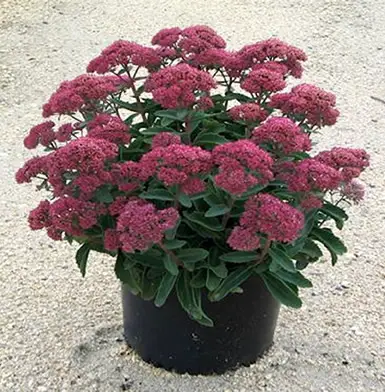
Taller upright varieties are perfect for borders or container displays.
Most sedums are deer-resistant, drought-tolerant, and excellent pollinator attractors.
Just be sure the soil doesn’t stay wet—especially in the cooler months.
Most Popular Sedum Varieties
Burro’s Tail (Sedum morganianum)
A trailing variety with thick, blue-green leaves that grow along long, draping stems.
Perfect for hanging baskets indoors.
Burrito (Sedum burrito)
Similar to Burro’s Tail but with shorter, rounder leaves.
It grows densely and cascades beautifully from shelves and pots.
Autumn Joy (Sedum spectabile ‘Autumn Joy’)
A hardy, upright sedum with pink flowers that turn copper in the fall.
Great for outdoor gardens and attracts butterflies.
Matrona (Sedum telephium ‘Matrona’)
An upright variety with pinkish stems and dusky purple-green foliage.
Blooms in late summer and pairs well with ornamental grasses.
Stonecrop (Sedum acre)
A low-growing, spreading variety often used as ground cover.
Features tiny golden yellow flowers and thrives in rock gardens.
Angelina (Sedum rupestre ‘Angelina’)
A vibrant chartreuse groundcover that turns orange in cooler weather.
Very hardy and excellent for edging paths or containers.
Lemon Coral (Sedum mexicanum ‘Lemon Coral’)
Bright, lime-green foliage that holds its color year-round.
Commonly used in containers or as filler in succulent arrangements.
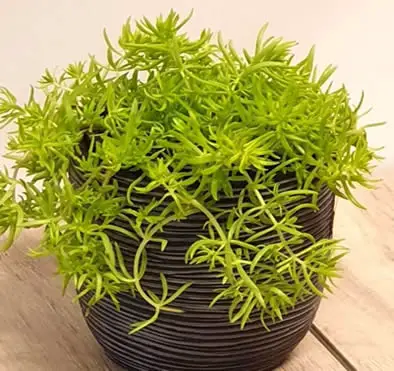
Golden Moss (Sedum acre ‘Aureum’)
A miniature, moss-like sedum with golden yellow-green foliage.
Spreads quickly and thrives in poor soil or tight spaces.
Lemon Ball (Sedum reflexum ‘Lemon Ball’)
A sun-loving variety with spiky, lime-colored foliage.
It forms mounds and is perfect for mass planting or borders.
Sedum adolphii (Golden Sedum)
A spreading succulent with rosettes that turn orange at the tips when exposed to strong light.
Great for sunny windows or outdoor planters.
Sedum treleasei
A chunky-leaved succulent with blue-green rosettes.
Slow-growing but tough, it’s ideal for containers or dry gardens.
Common Problems and Fixes
Shriveled leaves
This usually means the plant is under-watered or has been in very hot conditions.
Water thoroughly and move to slightly less intense light.
Mushy leaves or stems
Overwatering or poor drainage is the cause.
Remove affected parts and let the soil dry completely before watering again.
Leggy growth
Not enough light. Move your sedum to a brighter location and consider pruning to encourage fuller regrowth.
Pale or faded color
Lack of light or nutrients can cause faded color.
Increase sunlight exposure and consider a light feeding in the growing season.
Leaf drop
Can be a response to overwatering or sudden changes in light or temperature.
Let the plant stabilize in a bright, steady environment.
Final Thoughts
Sedum is a rewarding plant that offers beauty, resilience, and versatility with very little effort.
With just a sunny spot, fast-draining soil, and occasional watering, these hardy succulents will thrive both indoors and out.
From cascading stems to compact mats and upright blooms, there’s a sedum for every taste and setting—making them a must-have for any succulent lover, beginner or expert alike.

